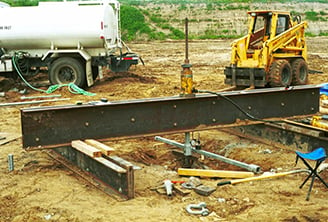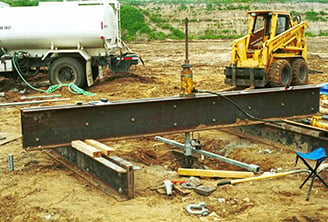 Predicting the holding capacity of an anchor can be difficult due to soil variations at different depths and different structure sites. It is critical to understand anchor capacity to ensure the integrity of your guyed structures.
Predicting the holding capacity of an anchor can be difficult due to soil variations at different depths and different structure sites. It is critical to understand anchor capacity to ensure the integrity of your guyed structures.
Measuring torque during the installation of a screw anchor is a reliable way to predict the holding capacity, but a pull test gives you the added assurance the anchor will hold during high load conditions.
Testing of guy anchors falls into two categories, Pre-Production and Production Tests
- Pre-Production test: A test that is often done to determine if an anchoring system or installation method will provide the ultimate capacity needed for a project. A pre-production(sacrificial) anchor is installed just for the test and will not be used to guy a structure.
- Production test: After an anchoring system has been chosen for a project, a production test is done on all or a sample number of anchors to verify capacity. This may be the only type of load test conducted, depending on project conditions.
The anchor test proposal shall be in general conformance with ASTM D-3689, and shall provide the minimum following information:
- Type and accuracy of load equipment
- Type and accuracy of load measuring equipment
- Type and accuracy of anchor-head deflection measuring equipment
- General description of load reaction system
- Calibration report for complete load equipment, including hydraulic jack, pump, pressure gauge, hoses, and fittings. This calibration is to be for the exact equipment that will be used in the field for load testing.
For more information on Load Test Procedures, click on this link to see the Anchor Load Testing guide.

